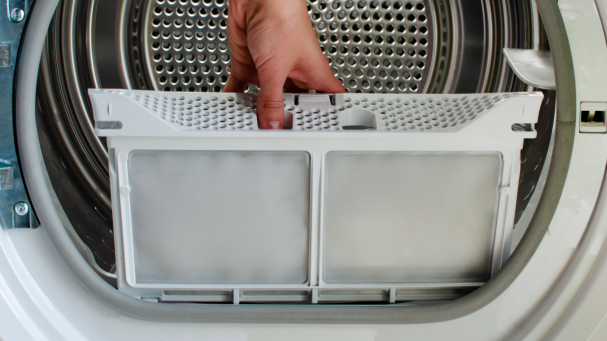When we think of cleaning our homes, we often forget about some of the hardest-working items—our appliances. Even though they’re responsible for keeping our clothes, dishes, and homes fresh and spotless, these machines need a little extra love too. A regular deep clean not only extends their lifespan but also keeps them performing at their best. Here’s why you need to make it a habit and how to deep clean two key appliances: the washing machine and the tumble dryer.
ALSO SEE: 5 clear benefits of washing your clothes inside out
Why deep cleaning matters
Over time, appliances like washing machines and tumble dryers accumulate dirt, grime, and even mould that can impact their effectiveness. A washing machine, for example, can develop buildup from detergent and fabric softener, which can affect your clothes’ cleanliness and even start to smell. Similarly, a tumble dryer’s lint and dust buildup can reduce its efficiency and, in some cases, pose a fire hazard. By deep cleaning these appliances, you’re protecting your investment, ensuring your clothes stay fresh, and reducing potential hazards.

Pexels
How to clean a front-loader washing machine
Front-load washing machines are known for their energy efficiency and water-saving capabilities, but they’re also prone to developing mould and mildew, which can lead to unpleasant odours. Here’s a step-by-step guide to deep clean your front loader, along with some tips to keep it smelling fresh.
Steps to deep clean your washing machine
- Empty the drum: Remove any items from the machine before you begin.
- Clean the gasket: The rubber seal around the door (gasket) is where mould and mildew tend to build up. Use a mixture of equal parts vinegar and water with a microfiber cloth to wipe it down. Don’t forget to pull back the seal to reach any hidden areas, as this is where residue can collect.
- Run a hot wash cycle with vinegar: Add two cups of white vinegar directly into the drum and run the hottest, longest cycle available. Vinegar breaks down mineral deposits, kills mould, and deodorizes the machine.
- Follow with a baking soda rinse: After the vinegar cycle, add half a cup of baking soda to the drum and run another hot cycle. Baking soda helps lift any remaining grime and leaves the machine smelling fresh.
- Wipe down the drum and door: Use a dry cloth to wipe down the drum, door, and any visible surfaces. This removes any leftover residue.
Our top tips and tricks
- Leave the door open: After each wash, leave the door slightly open to let the drum air out. This prevents moisture buildup and helps avoid that musty smell.
- Wipe the gasket after each use: Use a cloth to quickly wipe the gasket after every load, removing any lingering water or detergent residue.
- Use the right amount of detergent: Too much detergent can create excess suds, which lead to buildup over time. Follow the recommended amount on the detergent packaging.
How to stop your washing machine from smelling
- Run a monthly maintenance cycle: A monthly vinegar and baking soda cycle will keep odour-causing mould and mildew at bay.
- Switch to powder detergent or high-efficiency (HE) liquid detergent: These detergents create fewer suds and don’t leave behind as much residue, reducing buildup.
- Add a dehumidifier nearby: If your laundry area is damp, a dehumidifier can help reduce moisture in the air, preventing mould from forming inside the machine.

Pexels
The right way to clean your tumble dryer
Dryers collect lint and dust over time, which can clog up the system and reduce efficiency. Worse, lint buildup is a leading cause of dryer fires. Regular deep cleaning keeps your dryer in top shape and ensures it runs safely. Here’s how to clean it thoroughly.
Steps to deep clean your tumble dryer
- Clean the lint trap: After every cycle, empty the lint trap. Once a month, remove the trap and wash it with warm, soapy water to remove any film that can collect from dryer sheets.
- Wipe down the drum: Use a damp cloth with mild detergent to wipe the interior of the drum. This removes any residue from fabric softeners or dryer sheets that can collect on the drum.
- Clean the vent system: Every six months, unplug the dryer and clean the vent hose (the part that connects to the outside). Use a vacuum to remove lint from both the hose and the vent, or use a dryer vent cleaning brush for hard-to-reach areas.
- Inspect the exhaust vent: Check the outside vent where air exits your home to make sure it’s clear of debris. Remove any lint or dust blocking the vent to prevent airflow restriction.

Canva Stock Images
Our top tips and tricks
- Use dryer balls instead of dryer sheets: Dryer sheets can leave a residue that builds up over time. Dryer balls are reusable, reduce drying time, and won’t create a residue on the drum or lint trap.
- Empty the lint trap every time: This simple habit reduces lint buildup and keeps your dryer running efficiently.
- Limit the use of fabric softener: Liquid softeners can leave a film on clothes that transfers to the dryer drum. Opt for dryer balls or reusable dryer sheets instead.
How to keep your dryer clean
- Vacuum around the dryer regularly: Lint can collect around and under the dryer, posing a potential fire hazard. Make a habit of vacuuming these areas monthly.
- Schedule an annual professional inspection: If you’re not comfortable cleaning the vent system yourself, a professional can ensure it’s clear and in top condition.
- Keep the door open: Like the washing machine, keeping the dryer door open when not in use allows airflow and prevents a buildup of stale odours.
ALSO SEE:
Time to clean out your home with these toxin-free strategies
Featured Image: Canva Stock Images

